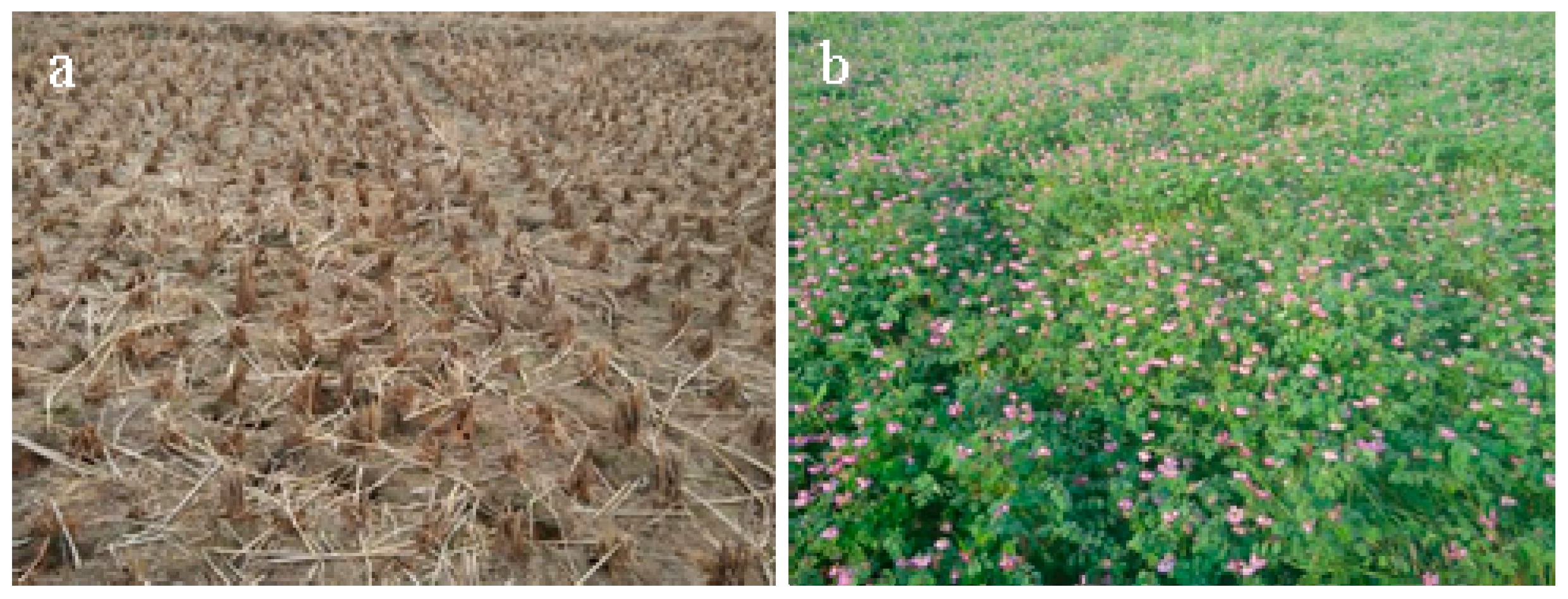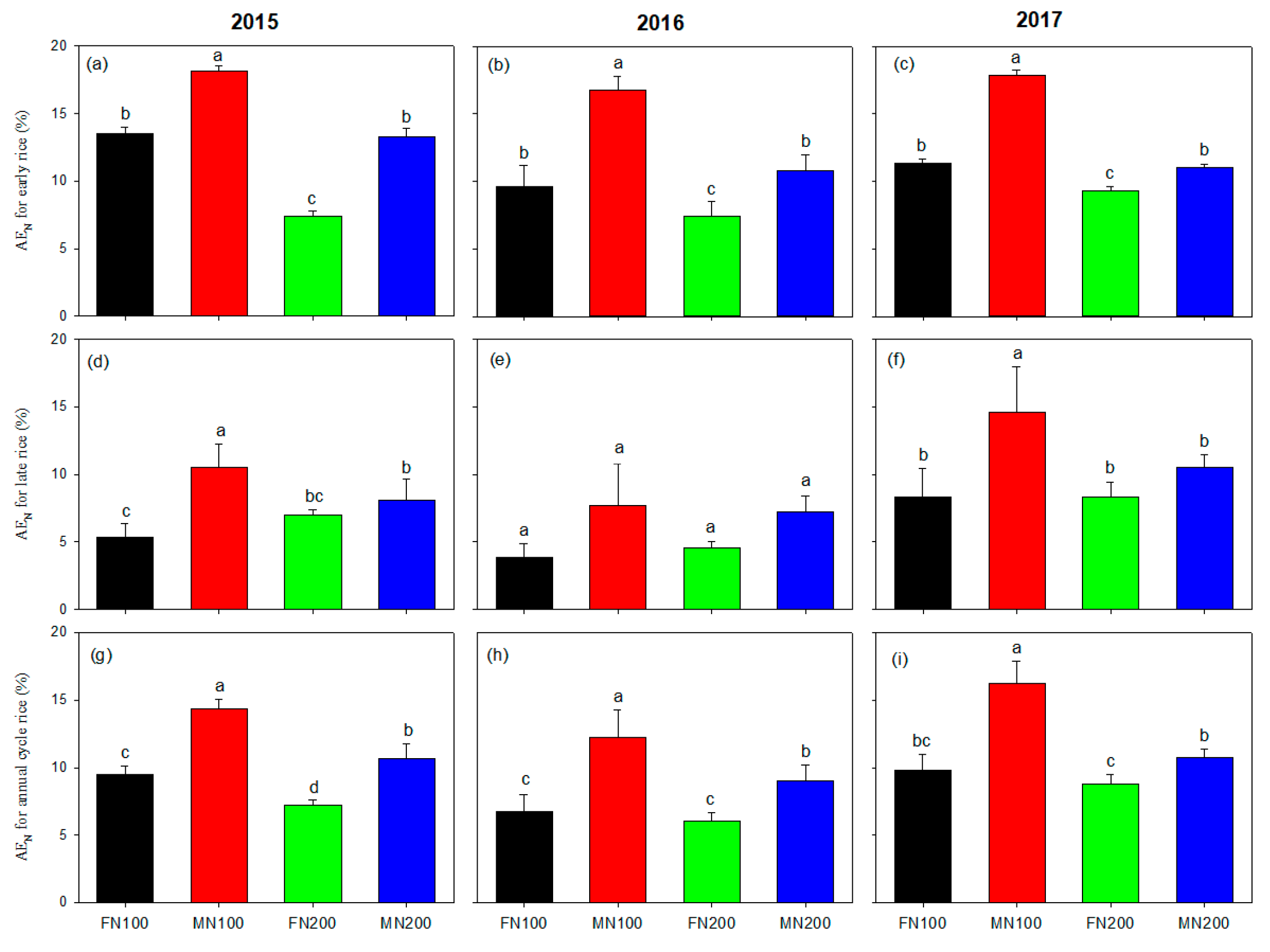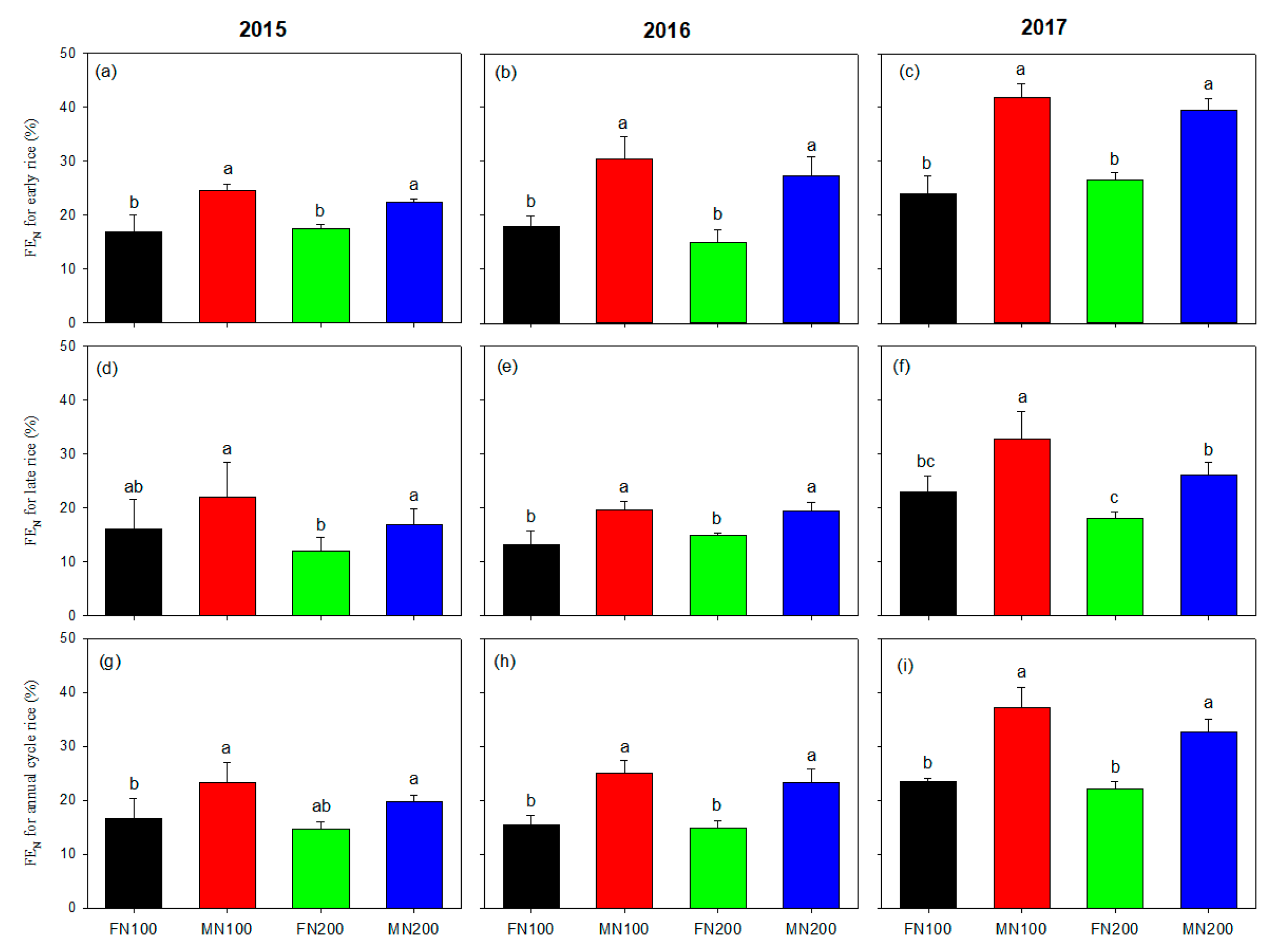Leguminous Cover Crop Astragalus sinicus Enhances Grain Yields and Nitrogen Use Efficiency through Increased Tillering in an Intensive Double-Cropping Rice System in Southern China
Abstract
:1. Introduction
2. Materials and Methods
2.1. Experimental Site
2.2. Treatments and Crop Management
2.3. Sample Collection and Analysis
2.4. Statistical Analyses
3. Results
3.1. Grain Yield and Yield Components
3.2. N Uptake
3.3. N Use Efficiency
4. Discussion
4.1. Effect of Vetch Winter Cropping on Rice Grain Yield
4.2. Effect of Vetch on Rice N Uptake and N Use Efficiency
5. Conclusions
Author Contributions
Funding
Acknowledgments
Conflicts of Interest
References
- Peng, S.; Buresg, R.J.; Huang, J.; Zou, Y.; Zhong, X.; Wang, G.; Zhang, F. Strategies for overcoming low agronomic nitrogen use efficiency in irrigated rice systems in China. Field Crops Res. 2006, 96, 37–47. [Google Scholar] [CrossRef]
- Ju, X.; Xing, G.; Chen, X.; Zhang, S.; Zhang, L.; Liu, X.; Cui, Z.; Yin, B.; Christie, P.; Zhu, Z.; et al. Reducing environmental risk by improving N management in intensive Chinese agricultural systems. Proc. Natl. Acad. Sci. USA 2009, 106, 3041–3046. [Google Scholar] [CrossRef] [PubMed] [Green Version]
- Galloway, J.N.; Townsend, A.R.; Erisman, J.W.; Bekunda, M.; Cai, Z.; Freney, J.R.; Martinelli, L.A.; Seitzinger, S.P.; Sutton, M.A. Transformation of the nitrogen cycle: Recent trends, questions, and potential solutions. Science 2008, 320, 889–892. [Google Scholar] [CrossRef] [PubMed]
- Liu, X.; Zhang, Y.; Han, W.; Tang, A.; Shen, J.; Cui, Z.; Vitousek, P.; Erisman, J.W.; Goulding, K.; Christie, P.; et al. Enhanced nitrogen deposition over China. Nature 2013, 494, 459–462. [Google Scholar] [CrossRef] [PubMed]
- Geng, J.; Ma, Q.; Chen, J.; Zhang, M.; Li, C.; Yang, Y.; Yang, X.; Zhang, W.; Liu, Z. Effects of polymer coated urea and sulfur fertilization on yield, nitrogen use efficiency and leaf senescence of cotton. Field Crops Res. 2016, 187, 87–95. [Google Scholar] [CrossRef]
- Chen, Y.; Peng, J.; Wang, J.; Fu, P.; Hou, Y.; Zhang, C.; Fahad, S.; Peng, S.; Cui, K.; Nie, L.; et al. Crop management based on multi-split topdressing enhances grain yield and nitrogen use efficiency in irrigated rice in China. Field Crops Res. 2015, 184, 50–57. [Google Scholar] [CrossRef]
- Ramírez-García, J.; Carrillo, J.M.; Ruiz, M.; Alonso-Ayuso, M.; Quemada, M. Multicriteria decision analysis applied to cover crop species and cultivars selection. Field Crops Res. 2015, 175, 106–115. [Google Scholar] [Green Version]
- Campiglia, E.; Mancinelli, R.; Radicetti, E.; Marinari, S. Legume cover crops and mulches: Effects on nitrate leaching and nitrogen input in a pepper crop (Capsicum annuum L.). Nutr. Cycl. Agroecosyst. 2011, 89, 399–412. [Google Scholar] [CrossRef]
- Gabriel, J.L.; Quemada, M. Replacing bare fallow with cover crops in a maize cropping system: Yield, N uptake and fertilizer fate. Europ. J. Agron. 2011, 34, 133–143. [Google Scholar] [CrossRef]
- Baijukya, F.P.; de Ridder, N.; Giller, K.E. Nitrogen release from decomposing residue of leguminous cover crops and their effect on maize yield on depleted soil of Bukoba District, Tanzania. Plant Soil 2006, 279, 77–93. [Google Scholar] [CrossRef]
- Tribouillois, H.; Cohan, J.P.; Justes, E. Cover crop mixtures including legume produce ecosystem services of nitrate capture and green manuring: Assessment combining experimentation and modeling. Plant Soil 2016, 401, 347–364. [Google Scholar] [CrossRef]
- Zhu, B.; Yi, L.; Hu, Y.; Zeng, Z.; Lin, C.; Tang, H.; Yang, G.; Xiao, X. Nitrogen released from incorporated 15N-labelled Chinese milk vetch (Astragalus sinicus L.) residue and its dynamics in a double rice cropping system. Plant Soil 2014, 374, 331–344. [Google Scholar] [CrossRef]
- Bremner, J.M.; Mulvaney, C.S. N-Total. In Methods of Soil Analysis, Part 2; Page, A.L., Miller, R.H., Keeney, D.R., Eds.; American Society of Agronomy: Madison, WI, USA, 1982; pp. 595–624. [Google Scholar]
- Xu, Y.; Nie, L.; Buresh, R.; Huang, J.; Cui, K.; Xu, B.; Gong, W.; Peng, S. Agronomic performance of late-season rice under different tillage, straw, and nitrogen management. Field Crops Res. 2010, 115, 79–84. [Google Scholar] [CrossRef]
- Constantin, J.; Mary, B.; Laurent, F.; Aubrion, G.; Fontaine, A.; Kerverillant, P.; Beaudoin, N. Effects of catch crops, no till and reduced nitrogen fertilization on nitrogen leaching and balance in three long-term experiments. Agric. Ecosyst. Environ. 2010, 135, 268–278. [Google Scholar] [CrossRef]
- Deligios, P.A.; Tiloca, M.T.; Sulas, L.; Buffa, M.; Caraffini, S.; Doro, L.; Sanna, G.; Spanu, E.; Spissu, E.; Urracci, G.R.; et al. Stable nutrient flows in sustainable and alternative cropping systems of globe artichoke. Agron. Sustain. Dev. 2017, 37, 54–65. [Google Scholar] [CrossRef]
- Zhu, B.; Yi, L.; Guo, L.; Chen, G.; Hu, Y.; Tang, H.; Xiao, X.; Yang, G.; Surya, N.A.; Zeng, Z. Performance of two winter cover crops and their impacts on soil properties and two subsequent rice crops in Dongting Lake Plain, Hunan, China. Soil Tillage Res. 2012, 124, 95–101. [Google Scholar] [CrossRef]
- Claire, C.; John, D.L.; Bill, D.; Laura, L.V.E. Legume cover crop management on nitrogen dynamics and yield in grain corn systems. Field Crops Res. 2017, 201, 75–85. [Google Scholar]
- Gaudin, A.; Janovicek, K.; Martin, R.C.; Deen, W. Approaches to optimizing nitrogen fertilization in a winter wheat-red clover (Trifolium pratense L.) relay cropping system. Field Crops Res. 2014, 155, 192–201. [Google Scholar] [CrossRef]
- Katterings, Q.M.; Swink, S.N.; Duikr, S.W.; Czymmek, K.J.; Beegle, D.B.; Cox, W.J. Integrating cover crops for nitrogen management in corn systems on Northeastern U.S. dairies. Agron. J. 2015, 107, 1365–1376. [Google Scholar] [CrossRef]
- Diekmann, K.K.; Ottow, J.C.G.; De Datta, S.K. Yield and nitrogen response of lowland rice (Oryza sativa L.) to Sebania rostrata and Aeschynomeme afraspera green manure in different marginally productive soils in Philippines. Biol. Fertil. Soils 1996, 21, 103–108. [Google Scholar] [CrossRef]
- Lee, C.H.; Park, K.D.; Jung, K.Y.; Ali, M.A.; Lee, D.; Gutierrez, J.; Kim, P.J. Effects of Chinese milk vetch (Astragalus sinicus L.) as a green manure on rice productivity and methane emission in paddy soil. Agric. Ecosyst. Environ. 2010, 138, 343–347. [Google Scholar] [CrossRef]
- Yu, Y.; Xue, L.; Yang, L. Winter legumes in rice crop rotations reduces nitrogen loss, and improves rice yield and soil nitrogen supply. Agron. Sustain. Dev. 2014, 34, 633–640. [Google Scholar] [CrossRef]
- Xu, H.; Zhu, B.; Liu, J.; Li, D.; Yang, Y.; Zhang, K.; Jiang, Y.; Hu, Y.; Zeng, Z. Azolla planting reduces methane emission and nitrogen fertilizer application in double rice cropping system in southern China. Agron. Sustain. Dev. 2017, 37, 29–38. [Google Scholar] [CrossRef]
- Xie, J.; Hu, L.; Tang, J.; Wu, X.; Li, N.; Yuan, Y.; Yang, H.; Zhang, J.; Luo, S.; Chen, X. Ecological mechanisms underlying the sustainability of the agricultural heritage rice-fish coculture system. Proc. Natl. Acad. Sci. USA 2011, 108, 1381–1387. [Google Scholar] [CrossRef] [PubMed]
- Buresh, R.J.; Reddy, K.R.; van Kessel, C. Nitrogen transformations in submerged soils. In Nitrogen in Agricultural Systems, Agronomy Monograph 49; Schepers, J.S., Raun, W.R., Eds.; ASA, CSSA and SSSA: Madison, WI, USA, 2008; pp. 401–436. [Google Scholar]
- Witt, C.; Cassman, K.G.; Olk, D.C.; Biker, U.; Liboon, S.P.; Sanson, M.I.; Ottow, J.C.G. Crop rotation and residue management effects on carbon sequestration, nitrogen cycling and productivity of irrigated rice systems. Plant Soil 2000, 225, 263–278. [Google Scholar] [CrossRef]
- Asagi, N.; Ueno, H. Nitrogen dynamics in paddy soil applied with various 15N-labelled green manures. Plant Soil 2009, 322, 251–262. [Google Scholar] [CrossRef]
- Ashraf, M.; Mahnood, T.; Azam, F.; Qureshi, R.M. Comparative effects of applying leguminous and non-leguminous green manures and inorganic N on biomass yield and nitrogen uptake in flooded rice (Oryza sativa L.). Biol. Fertil. Soils 2004, 40, 147–152. [Google Scholar] [CrossRef]
- Shan, Y.H.; Johnson-Beebout, S.E.; Buresh, R.J. Crop residue management for lowland rice-based cropping systems in Asia. Adv. Agron. 2008, 98, 117–199. [Google Scholar]
- Yao, Y.; Zhang, M.; Tian, Y.; Zhao, M.; Zhang, B.; Zhao, M.; Zeng, K.; Yin, B. Duckweed (Spirodela polyrhiza) as green manure for increasing yield and reducing nitrogen loss in rice production. Field Crops Res. 2017, 214, 273–282. [Google Scholar] [CrossRef]
- Srivastava, J.K.; Chandra, H.; Kalra, S.J.S.; Mishra, P.; Khan, H.; Yadav, P. Plant-microbe interaction in aquatic system and their role in the management of water quality: A review. Appl. Water Sci. 2017, 7, 1079–1090. [Google Scholar] [CrossRef]
- Xie, Z.; He, Y.; Tu, S.; Xu, C.; Liu, G.; Wang, H.; Cao, W.; Liu, H. Chinese Milk Vetch improves plant growth, development and 15N recovery in the rice-based rotation system of South China. Sci. Rep. 2017, 7, 3577. [Google Scholar] [CrossRef] [PubMed]
- Yuan, M.; Liu, Q.; Zhang, S. Characteristics of nitrogen fixation of winter green manure in paddy soil in the Taihu Lake area. Chin. J. Soil Sci. 2010, 41, 1115–1119. (In Chinese) [Google Scholar]




| Source of Variation | Early Rice | Late Rice | Annual Cycle Rice | |||||||||
|---|---|---|---|---|---|---|---|---|---|---|---|---|
| Grain Yield | Total N Uptake | AEN | REN | Grain Yield | Total N Uptake | AEN | REN | Grain Yield | Total N Uptake | AEN | REN | |
| Year (Y) | 217.2 ** | 58.6 ** | 6.5 ** | 28.7 ** | 191.9 ** | 173.8 ** | 7.1 ** | 7.8 ** | 100.7 ** | 144.1 ** | 7.1 ** | 22.3 ** |
| Treatment (T) | 359.8 ** | 144.8 ** | 78.0 ** | 21.3 ** | 89.0 ** | 92.0 ** | 5.1 ** | 4.7 * | 272.8 ** | 164.0 ** | 21.8 ** | 14.9 ** |
| Y × T | 4.3 ** | 5.0 ** | NS | NS | NS | NS | NS | NS | NS | 4.0 ** | NS | NS |
| Treatment | 2015 | 2016 | 2017 | ||||||
|---|---|---|---|---|---|---|---|---|---|
| Early Rice (Mg ha−1) | Late Rice (Mg ha−1) | Annual Rice Cycle a (Mg ha−1) | Early Rice (Mg ha−1) | Late Rice (Mg ha−1) | Annual Rice Cycle (Mg ha−1) | Early Rice (Mg ha−1) | Late Rice (Mg ha−1) | Annual Rice Cycle (Mg ha−1) | |
| FN0 | 4.90 e | 4.52 d | 9.42 d | 4.34 d | 4.25 d | 8.59 d | 3.96 d | 5.24 d | 9.19 d |
| FN100 | 6.26 d | 5.06 c | 11.32 c | 5.30 c | 4.64 c | 9.94 c | 5.09 c | 6.07 c | 11.16 c |
| MN100 | 6.72 b | 5.58 b | 12.29 b | 6.02 b | 5.021 b | 11.03 b | 5.74 b | 6.70 b | 12.44 b |
| FN200 | 6.38 c | 5.92 a | 12.31 b | 5.83 b | 5.17 b | 11.00 b | 5.81 b | 6.91 b | 12.72 b |
| MN200 | 7.56 a | 6.15 a | 13.70 a | 6.51 a | 5.69 a | 12.20 a | 6.15 a | 7.35 a | 13.50 a |
| Treatment | Early Rice | Late Rice | ||||||
|---|---|---|---|---|---|---|---|---|
| Panicles (m−2) | Spikelets Panicle−1 | Grain Filling (%) | Grain Weight (mg) | Panicles (m−2) | Spikelets Panicle−1 | Grain Filling (%) | Grain Weight (mg) | |
| 2015 | ||||||||
| FN0 | 192 d | 108 a | 79 a | 27 a | 177 b | 132 a | 87 a | 24 a |
| FN100 | 249 c | 120 a | 77 a | 27 a | 178 b | 133 a | 89 a | 24 a |
| MN100 | 261 b | 101 a | 79 a | 29 a | 205 a | 131 a | 89 a | 24 a |
| FN200 | 276 b | 114 a | 76 a | 26 a | 210 a | 136 a | 87 a | 24 a |
| MN200 | 337 a | 116 a | 80 a | 25 a | 213 a | 135 a | 85 a | 24 a |
| 2016 | ||||||||
| FN0 | 151 d | 121 a | 79 a | 29 a | 228 c | 102 a | 65 a | 24 a |
| FN100 | 192 c | 123 a | 83 a | 28 a | 252 b | 102 a | 65 a | 24 a |
| MN100 | 222 b | 129 a | 80 a | 28 a | 286 a | 98 a | 66 a | 25 a |
| FN200 | 214 b | 141 a | 83 a | 27 a | 284 a | 114 a | 64 a | 23 a |
| MN200 | 250 a | 133 a | 78 a | 27 a | 298 a | 112 a | 63 a | 23 a |
| 2017 | ||||||||
| FN0 | 304 e | 67 a | 87 a | 25 a | 171 d | 129 a | 80 a | 24 a |
| FN100 | 354 d | 76 a | 84 a | 25 a | 198 c | 137 a | 79 a | 24 a |
| MN100 | 386 c | 69 a | 86 a | 26 a | 219 b | 143 a | 79 a | 25 a |
| FN200 | 415 b | 78 a | 84 a | 25 a | 246 a | 153 a | 73 a | 24 a |
| MN200 | 457 a | 64 a | 84 a | 26 a | 223 b | 144 a | 77 a | 25 a |
© 2019 by the authors. Licensee MDPI, Basel, Switzerland. This article is an open access article distributed under the terms and conditions of the Creative Commons Attribution (CC BY) license (http://creativecommons.org/licenses/by/4.0/).
Share and Cite
Nie, J.; Yi, L.; Xu, H.; Liu, Z.; Zeng, Z.; Dijkstra, P.; Koch, G.W.; Hungate, B.A.; Zhu, B. Leguminous Cover Crop Astragalus sinicus Enhances Grain Yields and Nitrogen Use Efficiency through Increased Tillering in an Intensive Double-Cropping Rice System in Southern China. Agronomy 2019, 9, 554. https://doi.org/10.3390/agronomy9090554
Nie J, Yi L, Xu H, Liu Z, Zeng Z, Dijkstra P, Koch GW, Hungate BA, Zhu B. Leguminous Cover Crop Astragalus sinicus Enhances Grain Yields and Nitrogen Use Efficiency through Increased Tillering in an Intensive Double-Cropping Rice System in Southern China. Agronomy. 2019; 9(9):554. https://doi.org/10.3390/agronomy9090554
Chicago/Turabian StyleNie, Jiangwen, Lixia Yi, Heshui Xu, Zhangyong Liu, Zhaohai Zeng, Paul Dijkstra, George W. Koch, Bruce A. Hungate, and Bo Zhu. 2019. "Leguminous Cover Crop Astragalus sinicus Enhances Grain Yields and Nitrogen Use Efficiency through Increased Tillering in an Intensive Double-Cropping Rice System in Southern China" Agronomy 9, no. 9: 554. https://doi.org/10.3390/agronomy9090554





